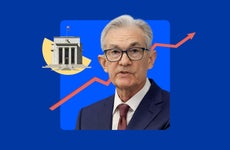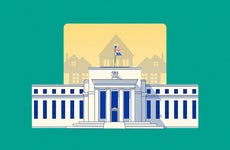How the Federal Reserve impacts savings account interest rates

The Bankrate promise
At Bankrate we strive to help you make smarter financial decisions. While we adhere to strict , this post may contain references to products from our partners. Here's an explanation for .
When the Federal Reserve changes interest rates, consumers feel the ripple effects in all sorts of ways.
For savers, banks offering top interest rates tend to pay more when the U.S. central bank hikes rates and less when it cuts them. The Fed decided at its June meeting to hold rates steady, effectively keeping the federal funds rate in a range between 5.25-5.50 percent.
The Fed also chose to leave interest rates alone in May, March and January, as well as during four of its rate-setting meetings in 2023. Last year, it also hiked rates by 25 basis points in July, May, March and January. In all, the Fed raised rates 11 times in 2022 and 2023.
“Where you have your cash parked really matters,” says Greg McBride, CFA, Bankrate chief financial analyst. “The top-yielding savings accounts and certificates of deposit remain the place to be as those are the banks that have raised their payouts and will remain competitive for savers’ money. Many banks — and especially large banks — were much stingier about passing along higher rates to savers.”
For anyone hoping to make saving money a top priority, here’s what to consider when the Fed makes a change to the federal funds rate.
The loose link between Fed rate hikes and your high-yield savings account
Congress mandates the Fed maintain economic and financial stability. The central bank mostly does so by raising or lowering the cost of borrowing money. Savings account rates are loosely linked to the rates the Fed sets. After the central bank raises its rate, financial institutions tend to pay more interest on high-yield savings accounts to stay competitive and attract deposits. Conversely, after the Fed lowers its rate, banks tend to lower their deposit account rates.
The fed funds rate was taken all the way down to a range of zero to 0.25 percent in March 2020 in response to the worldwide COVID-19 pandemic. But 40-year-high inflation prompted the Fed to raise rates in 2022 by 4.25 percentage points over seven meetings throughout the year, including four hikes of 0.75 percentage points each. In 2023, a total of four, 0.25-percentage-point rate hikes took place.
Policymakers’ decision to leave rates untouched for the seventh straight meeting comes at a time when the annual inflation rate (currently at 3.3 percent) isn’t cooling as quickly as it once was. As a result, competitive banks are offering the highest yields on consumer deposits in more than a decade.
Online banks tend to compete for customers with comparatively high rates, while brick-and-mortar banks tend to avoid paying savers competitive yields. The rates on savings accounts vary drastically, and they can change at any time. Large brick-and-mortar banks, such as Chase and Bank of America, are still paying around 0.01 percent annual percentage yield (APY), while top high-yield savings accounts offer up to 5.30 percent APY — or 530 times more.
Escalating competition is one reason for the disparity in yields. Online banks are in hot pursuit to attract and keep deposits as fintech competitors continue to enter the marketplace. Offering a high-yield account is among the tried-and-true strategies to court customers with a compelling offer — especially for relatively new and small digital banks.
Deposits, in general, are essential to banks’ business models: They are used as a low-cost funding source to fuel loan demand.
“Bankers don’t get deposits just because it’s cool to have deposits,” says Neil Stanley, CEO and founder of The CorePoint, a bank management services company. “They get them because they can invest them in loans.”
If banks make money by investing deposits in loans, then they can afford to pay more for deposits. Spoiler alert: banks are (usually) profitable.
Not every bank is hungry for more deposits. Whether and when banks respond to the Fed changing the rate will vary based on what objectives they are trying to accomplish. Online banks — which are often hungry for deposits — are likely to follow suit when the Fed raises rates, while established brick-and-mortar banks often don’t keep up with Fed rate hikes by raising their own savings account rates.
“Every bank could be a little different on this in terms of what their pressures are,” says Betty Cowell, a former senior advisor at consultant firm Simon-Kucher & Partners.
How to maximize your savings rate
Though the average yield on a traditional savings account is a paltry 0.58 percent, some banks offer high-yield savings accounts paying around 5 percent APY — or nearly nine times more. These accounts won’t do much to counter high prices at the pump and grocery store, but they will help you earn something.
“With online savings accounts yielding more than 5 percent, your emergency fund is no longer a drag on your portfolio,” says McBride. “Although the primary benefit of emergency savings is the immediate access to cash that shields you from high-cost debt or forced asset sales when unplanned expenses arise, you continue to be compensated for that savings in a way you haven’t for more than 15 years.”
Online banks are known for offering the highest yields, but it pays to shop around. Also, consider cash management accounts and money market accounts to find the best deals. If you’re able to park your cash for a set period, consider a short-term CD.
“For investors looking for predictable interest income, CDs will provide that and without the price volatility and default concerns that many bonds have,” says McBride. “Just don’t compromise your emergency savings to chase yield in a CD unless the bank is offering a way to cash in early without penalty should the money be needed.”
As you search for the best bank account for you:
- Compare APYs
- Read the fine print about fees
- Understand any minimum balance requirements
- Make sure the account offers the features you need
“If you are a shopper in the market today,” says Cowell, “hop online and compare prices and go with the brand you trust.”
Related Articles



What is the federal funds rate? How the Fed controls interest rates, explained
